Christmas – no extra pay, no day off, not even a gift card

Image courtesy of Kylie_Jaxxon on Flickr under the auspices of a Creative Commons license. https://www.flickr.com/photos/kyliejaxxon/50649471396
On my way to the office this morning I stopped by a local convenience store to pick up a bottle of Diet Pepsi. I had five hours of work ahead of me before I could enjoy the Christmas “holiday.”
The convenience store was open. A tired elderly woman hugging a bag of something – maybe what would pass for her Christmas dinner – struggled to get the door open and then hurried off down the sidewalk. I don’t know why but I had a sneaking suspicion she didn’t have a place to live, and this would be the highlight of her day.
I went inside just as another vehicle, a pickup truck, pulled up. A man got out and headed for the front door. He was grinning ear-to-ear. Good for him.
I found a Diet Pepsi in the cooler and returned to the register. The cashier was doing something in another part of the store, but he stopped and went behind the counter to ring up my soda. I had seen him before because I had stopped at this story many, many times before.
“How did you get so lucky to work on Christmas morning?” I asked, chuckling.
“We all have to work,” he barked back, not happy. “All of us. Nobody gets the day off.”
I made some kind of consolatory noise and he continued, “No day off, no extra pay, not even a $5 gift card. Cheapest company I ever worked for.”
He was angry.
“In 65 years I never had to work on Christmas. This will be the last time. I’ve got to get out of this place.”
He handed me my change and said, “But YOU have a nice Christmas.” I picked up my Diet Pepsi and left as the grinning man headed toward the angry cashier.
I’d like to say there’s a moral to this anecdote, or some kind of silver lining, just something that carries it to a higher level than mere observation on a working Christmas morning, but the fact is, life is life, and that’s what it’s like these days.
And I just thought I would share.
Image courtesy of Kylie_Jaxxon of Flickr under the auspices of a Creative Commons license.
Author’s note: Contact me at [email protected]. To read more of my opinion and humor pieces, visit delstonejr.com . I also write fiction – horror, science fiction and contemporary fantasy. If you’re a fan of such genres please check out my Amazon author’s page. Print and e-books are both available, and remember: You don’t need a Kindle device to read a Kindle e-book. Simply download the free Kindle app for your smart phone or tablet.
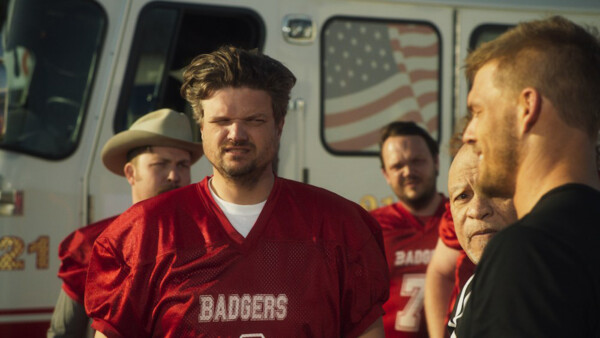
Image courtesy of Lionsgate.
“The Turkey Bowl” Starring Ryan Hansen, Matt Jones, Alan Ritchson, Kristen Hager and Barry Switzer. Directed by Greg Coolidge. 2 hours. Rated R. Hulu, Epix, DIRECTV.
Del’s take
After your gut has been stuffed, your nap wrapped up, the football games watched and the dishes scrubbed to gleaming perfection, plop your ass down in the recliner and dial up “The Turkey Bowl” on Hulu or Epix to complete your Thanksgiving Day playlist.
Like Aunt Martha’s green bean casserole, “The Turkey Bowl” is neither bland nor tart. It’s a vaguely smile-inducing low-fi comedy that tries hard to be a lot of things but in the end simply fails to offend, which means people will like it OK but nobody will ask for the recipe. That’s my Cliff Notes review and I’m sticking to it.
The story is about Hodges (Ryan Hansen) who exchanges his small-town Oklahoma roots for the big city. He has a high-powered girlfriend (Blair Bomar as Ashley Sinclair) whose father (Sean McGraw as Sen. Sinclair) is running for president, and a successful business career in Chicago that allows him to never visit Mom and Dad or any of his former friends back home, including a semi-jilted ex-girlfriend, Jen (Kristen Hager). His plan to propose to Ashley over the Thanksgiving holiday at Daddy’s ski lodge in Colorado is derailed when he learns his best friend from high school, Mitchell (Matt Jones), has died. So he returns for the funeral, only to discover it was all a ruse to lure him back for a legendary football game between the Putnam Badgers, for which he quarterbacked, and cross-town rivals the Noble Knights. The score was tied 7-7 when a sudden storm moved in and the game was never finished. That proved to be a thorn in the side of the Badgers, who hadn’t beaten the Knights since the 1950s, and Hodges’ former team members (now in the 30s and grossly out of shape) are strapping on the cleats to finish the game and with luck, bring home a win for the Badgers.
What follows is a series of events that can best be described as farce, some of which you already know and can easily predict the outcome – does Hodges reconnect with Jen? Do the Badgers win the game? Is Hodges able to hide his hometown antics from Ashley and her dad? I won’t give you the answers, but I’d lay money on your best guesses.
You’ve seen “The Turkey Bowl” a dozen times before, but that doesn’t mean you can’t enjoy it again. Expect crude language and nudity, and lots of physical humor mixed with meant-to-be-funny dialogue and sight gags (at one point Hodges is placed under “arrest” and cuffed with an ankle bracelet, which turns out to be a dog’s shock collar).
The problem with “The Turkey Bowl” is that it never lives up to its hilarious potential. The story and actors offer the promise of an extremely funny movie, with absurdity layered on absurdity like the hilarious classics of the past like “Airplane!” and “Christmas Vacation,” but somehow the jokes fall flat. My humble guess is the timing is off. Director Coolidge could have profited from tighter editing. It’s as if “Animal House” had been remade by The Hallmark Channel.
Still, as Thanksgiving movie fare goes it’s not a bad way to spend that part of the night between sneaking leftovers from the fridge and falling into a turkey-induced coma that carries you through to the morning. Look for a funny performance from Niceville’s own Alan Ritchson, and who would have thought Barry Switzer, former head coach of Oklahoma Sooners and the Dallas Cowboys, could not only act but be so funny?
“The Turkey Bowl” is no “Planes, Trains and Automobiles” and it will not become part of your Thanksgiving lore, but you could do worse. Did Bruce Willis ever make a Thanksgiving movie?
I give “The Turkey Bowl” a grade of B.

Mladen’s take
I watched “The Turkey Bowl” with a sour cranberries taste in my mouth that eventually subsided. The movie reminded me of my most ignominious act in high school. I dropped what would’ve been the winning touchdown pass during my school’s Homecoming football game. All I did was misjudge the trajectory of the approaching football by a couple of inches. Rather than the football floating over my right shoulder pad into my hands it hit it. Too much deflection. I was unable to adjust position to pluck the tumbling pigskin from the cool autumn air.
So, yeah, Del, much obliged for semi‑ruining my holidays because you chose “The Turkey Bowl” for us to review. You are responsible for traumatizing me with something I did decades ago.
The dropped pass memory triggered by Del is mitigated by the fact that for a few years after graduating high school, me and a group of high school friends would play a turkey-ish bowl of our own when we converged on the hometown for the holidays. I can’t recall if it was for Thanksgiving or during Christmas. The games weren’t against our county rival but they were fun. Sometimes there was snow on the ground.
Oh, the film. “The Turkey Bowl” is good enough to rationalize spending 120 minutes of your time if you’re properly fed and reclined to allow those weird semi-sleep states that I sometimes reach when I’m trying to avoid napping because it’ll screw my regular sleep. It’s also an adequate substitute for classic holiday – yes, I’m clumping Thanksgiving and Christmas together because, it seems, the U.S. is no longer interested in recognizing the two as events separated by time – movies such as “Planes, Trains, and Automobiles,” “Christmas Vacation,” “Home Alone,” and that overrated black-and-white one with whiny children and mysticism-tinged Christianity.
“The Turkey Bowl” takes patience. It’s like putting a meal into the crockpot. At first it’s raw but gets cooked and better fit for digestion over time. The beginning of the film annoyed me. It was campy, juvenile, and the acting a bit off. And, of course, there were cliches, particularly the one about old, out-of-shape men trying to relive their glorious youth by doing something nostalgic.
I wish the interaction among the Badgers when they were together, whether drinking or practicing for the bowl, was funnier. However, the scenes with our hero Hodges and his ex-girl Jen chit-chatting about this and that are charming. Also neatly set up was the contrast between Hodges’s blue-collar parents accepting him for who he is and his fiancée’s elitist liberal politicians trying to keep the image that they’re good, pure, and helpful intact. Hodges’s Mom eventually accepts that he’s a vegetarian and starts preparing vegetarian meals for him along with the hotdog casseroles and fried chicken for the Fox News-watching Dad. Hodges’s prospective father-in-law sics his bodyguard to spy on Hodges to make sure he does nothing to embarrass the politics- and money-driven U.S. senator who wants to be president.
“The Turkey Bowl” is a mash of movies we’ve all seen about a hometown boy leaving the hometown to do something great, coming back for some reason, and then staying for the simpler, happier life.
But, Del, a grade of B for the movie? No. Maybe you’re getting feely squishy because T-day and X-mas day are approaching and you want to be generous to show goodwill, but no. “The Turkey Bowl” is an intermittently entertaining film, which means it deserves a mid-grade grade. The movie is a C. It has just enough warmth and humor to make it an acceptable holiday flick. It will not become, for better or worse, a holiday classic.
Mladen Rudman is a former journalist and technical writer. Del Stone Jr. is a former journalist and author.

Image courtesy of Netflix.
“The Platform” (“El Hoyo”) Starring Ivan Massagué (Goreng), Zorion Eguileor (Trimagasi), Antonia San Juan (Imoguiri) and others. Directed by Galder Gaztelu-Urrutia. Rated for mature audiences. 1 hour, 34 minutes. Netflix.
Mladen’s take
“The Platform” is a very good movie that could’ve been great but for its descent into gratuitous violence.
How potentially great? The Spanish equivalent of South Korean “Parasite.” That’s how great. Recall that “Parasite” won the 2020 Oscar for Best Motion Picture. It was the first time a foreign film got the most prestigious nod from the Motion Picture Academy.
“The Platform,” perfectly kitted by a simple, soul‑scraping score from Aránzazu Calleja, buttresses what should be clear to all of us by now. Most humans are savages. There’s nothing those of us who aren’t can do about it.
Titled “El Hoyo” (The Hole) in Spanish, “The Platform” is a parable on many levels. Here’s the skinny, assuming I can summarize the movie’s plot.
The hoyo is an underground skyscraper with a rectangular cut centered on each subfloor. A levitating platform, a big ole block the parameter of an opulent dining table, packed with all sorts of food moves down through the subfloors, some three hundred of them. It stops at each subfloor, where the two often self-imprisoned occupants have 2 minutes to dine on whatever food there’s left. The inevitable kicker. The farther the platform descends the less food for the people below. Get it? It’s better to be on top.
Every 30 days, the Powers That Be gas the hoyo to move around the occupants. Those who were once at the top and had access to food before it disappeared may end up at the bottom and not get even scraps. The randomness of the monthly vertical displacement means hoyo occupants must prepare for survival, which often translates into murder and cannibalism, all of it vividly depicted again and again. Unfortunate. An imaginative, nicely acted movie about class gets distorted by “Hostel”-like violence. Let me say it again. Unfortunate.
There is terrific dialogue in this film. Goreng maintains most of his humanity, Trimagasi’s stark realism is understandable, and Imoguiri comes up with a solution for getting as many people as possible fed with the very limited supply of food on the platform. Her idea fails. Those above are unwilling to share with those below.
Maybe “The Platform” also riffs the fascist regime of Franco, who ruled Spain for decades starting in the late 1930s. There’s speculation by a character in the film – may have been Trimagasi, I can’t recall – that the Government was using the Hole as a social experiment to determine when regular folk would be pushed to the brink of cooperating to conquer mutually shared adversity such as hunger. Why? Because the underprivileged, who are always a vast majority of society, could coalesce into a rebellion with revenge as the goal if pushed too far. Who would be the target? The privileged, of course, including Government officials. Neat. The Government is trying to quantify how oppressive and depraved it can be before the masses take action to alter their miserable lives.
“The Platform” is a B+ 1 point from an A-. It pains me to give this terrific movie that grade. “El Hoyo” starts strong, stays strong to mid-point, and then deteriorates toward sadism to an unclear ending. Less splattering blood and fewer depictions of people carved for eating and, poof, “The Platform” would’ve reached A-land. Off I go to relive the film through Calleja’s masterful music, particularly “La Plataforma.” Oh, that insidious, almost lighthearted but certainly tinny tick-tocking as time to be humane runs out.
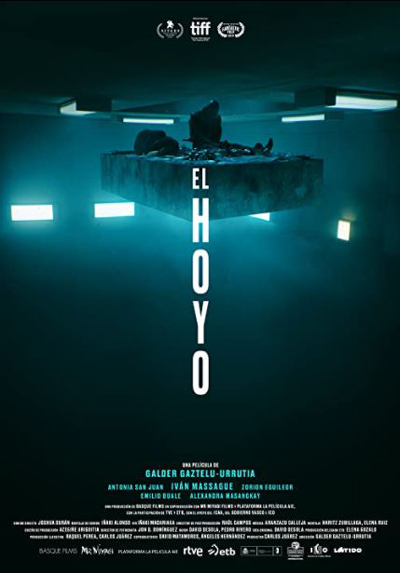
Del’s take
It’s not merely the Christmas spirit of charity that compels me to agree with Mladen. “The Platform” is a terrific movie ruined – for me, anyway – by graphic, stomach-churning violence. I don’t recommend it to anyone but those who can stomach extreme and bloody sadism.
A shame because it has crucial things to say about humanity, especially today, with knuckle-dragging, hate-spouting anti-intellectuals squabbling like pigs in a slophole over the dwindling largesse this planet has to offer. In fact, as the platform descended floor by floor, its offerings growing meager as it edged closer to an inferno of starvation and depravity, I saw the metaphor clearly:
That’s the world today. We are those people.
Speaking of which, moviegoers will not and have not embraced “The Platform” because they will not and have not embraced movies that offer such a bleak appraisal of the human condition. I maintain the portrayal is spot-on: With climate change, dwindling resources, division and untruth, a weird service-based economy and rampaging pandemics all around us, how can feeling good be a priority? What humanity needs is a swift kick in the ass and an admonition to get out there and change the world for the better. But that won’t happen, ever.
Most illustrative was the attitude changes of the people who shifted floors every month. A plan of action advanced by Goreng was that if each floor took only what it needed, even the people on the lowest levels would have something to eat, averting starvation and violence. Presumably the people on the lower levels, having suffered the greed and waste of those above them, would support such a strategy, but no. When they advance to the higher, more food-plentiful levels, the former low-level inhabitants become swine wallowing in an every-man-for-himself philosophy. Even when Goreng and a fellow cellmate try to organize the occupants of The Hole, or enforce their policy of selflessness, they’re defeated by anger and violence.
I watched this and was reminded of 2005, after Katrina devastated New Orleans and Fort Walton Beach became home to a flood of refugees from Louisiana who were buying gas, water and food and driving it back to the zone of destruction. I saw locals piling into gas stations, filling up the tanks on their gas-guzzling boats and personal watercraft as the lines grew longer and longer, and I wrote a column about it, admonishing those people to abstain from their personal pleasure so that our fellow Americans to the west could get back on their feet. The emails and letters I received were depressing – from people vowing to run all the gas out of their boats and return for a second helping, or more pointedly, that I go fuck myself.
For me that incident became a blunt illustration of humanity’s inherent savagery as Mladen put it, and I suppose “The Platform” seeks to be equally blunt. I personally could not get behind the blood, gore and depravity. Mladen argues the movie would have been better without all that but I’m not sure. I think when you soften the message, the message is lost on a lot of people. Subtlety is not one of our better qualities.
The ending? I won’t talk about the ending except to say it is dark. Literally. And darkness has always served as a metaphor for ignorance, decline, and evil.
Brace yourself for “The Platform.” You’ll never see it on The Hallmark Channel and that’s a good thing. When you’re done watching it, go out and do something unselfish. Make the world a tiny bit better.
Mladen Rudman is a technical writer and former journalist. Del Stone Jr. is a former journalist and writer.
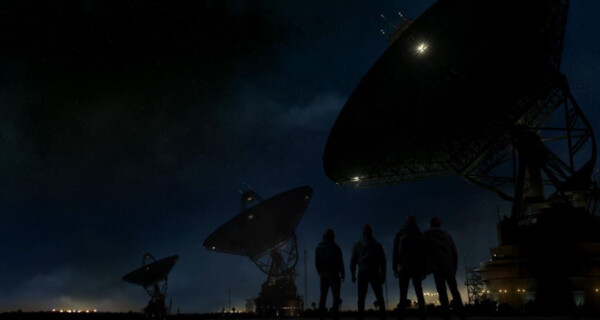
Image courtesy of Gravitas Features.
“Cosmos” Starring Tom England, Joshua Ford and Arjun Singh Panam. Directed by Eliot and Zander Weaver. 128 minutes. No rating available.
Del’s take
I spent the better part of my senior year in high school hanging out at my friend David’s garage. David was whatever you called a computer geek in the 1970s, and his garage was a trove of junk – boxes and bundles, cables and capacitors, all of it lying on the floor, hanging from the walls, spilling out of containers and littering the desktop where his ham radio sat. It had the class-action lawsuit smell of dangerous carcinogens and looked like a Jawa sandcrawler that had been ransacked by Imperial stormtroopers. We loved it.
“Cosmos” has a similar feel. It’s chock full of computer equipment, radio gear and bins with batteries and cables and God knows what, but it’s really about three guys and their niche interest – astronomy – and I will warn you front and center: It’s not for everybody. Most of the movie takes place behind the steamed-up windows of a Volvo stationwagon, and no, get your mind out of the gutter. It’s about bonding, friendship, and every other box that must be checked before a movie can earn the Steven Spielberg stamp of approval.
I can go two ways with this review. I can talk about “Cosmos” being a set piece with glacial pacing until you are thrown into the tacked-on, hair-raising final 5 minutes. Or I can talk about the fact that it was written, directed, lighted and photographed by two young brothers in one month for a total cost of $7,000. Avenue No. 1 leads to a C+ rating. Avenue No. 2 is a solid A. I am trending to No. 2 because “Cosmos” is blessed with something most movies don’t possess these days:
Love.
I’m talking about the intangible love endowed by creators who care about what they are doing, a love that can’t be articulated but somehow becomes obvious after the few minutes. “Cosmos” has a heaping helping of love, and that counts for a lot.
The story is about three astronomy buffs who head into the English countryside one night to hunt for a passing asteroid. Yet there’s tension – Roy (Arjun Singh Panam) was laid off from his engineering job just as a satellite he designed is lofted into orbit. His friend Harry (Joshua Ford), who worked for the same evil company and is the leader of their ad hoc stargazing group, the Astro-Nuts, replaced Roy with Mike (Tom England) when Roy stopped turning out. Mike is a radio astronomer and the misfit of their geeky troika.
During the night Mike sends a message into outer space and strange happenings commence – the message returns, a void is detected orbiting the Earth, and Roy and Harry hash out their differences – with an assist from Mike, who aspires to be a fully fledged member of the Nuts. To say anything else would spoil the movie.
Sound boring? Not to a SETI fanatic sporting a 5-inch reflector with a tracking motor and a crosshairs-illuminated spotting scope, hence the caveat: This movie is not for everyone. For those who might have hung out with me and David in his Jawa junk bin of a garage, it’s a gem.
But about that last 5 minutes. Ahem, guys: You totally abandoned the movie’s voice when you tacked on that last 5 minutes. And the payoff was, shall we say, a letdown? Only a person who has had an asteroid named after him or her could appreciate the payoff.
The two guys who made this movie are brothers Eliot and Zander Weaver, a pair of movie-loving Brits in their early 20s who said to hell with college, we’re making movies! “Cosmos” was shot mostly in a garage in a month with the bros doing all the work, and again, the total funds expended were $7,000. I expect that’ll attract the attention of a few beancounters.
Their talent for moviemaking is obvious: “Cosmos” has the look and feel a movie costing 10 times as much. Acting and direction are excellent, dialogue is excellent – it’s a well-done film and my jaw thudded against the desk when I read that $7,000 figure.
So I’m giving it an A, just because I want these guys to keep making movies.
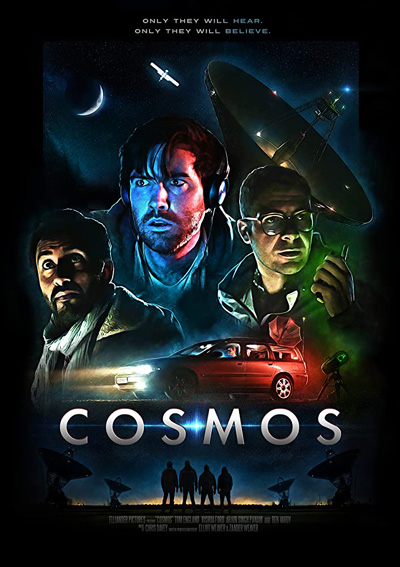
Mladen’s take
Del claims to be only one of two people on the planet who are perpetually skeptical about what they read on the Internet. But, he accepts the claim of the Brothers from Britain that “Cosmos” only cost them $7,000, or is that pounds, to make? If the latter, “Cosmos” was an $8,750 production. That’s a difference of 22 percent. Can I trust the souls, motivation, and marketing of the Brothers and their allegedly low-budget Indie attempt to make a serious movie as does Del or is “Cosmos” a feint? Maybe the movie is designed to dupe utopians such as Del, who go on to praise it, and, as word spreads, gets the Brothers a big budget for a much bigger movie bankrolled by Hollywood, Bollywood, or some Asian studio laundering money for the Chinese Communist Party or Kim Jung‑un.
“Cosmos” is a decent movie, whether you subscribe to Del’s Avenue 1 or Avenue 2 perspective, and nothing more. It succumbs to all the tropes you expect in movies: tension among characters; a dangerous and spooky outdoors; and some type of looming malfunction that risks everything the protagonists have accomplished.
Of those tropes, the first is the least objectionable. People are stupid. Who knows what triggers their moods and feelings and reactions and whatever other phenomena our yoga‑practicing society now identifies as maladies. When this “Cosmos” character dislikes that “Cosmos” character, though the latter had nothing to do with the former’s misfortune, I shrug and wonder when the story will get interesting again. A character’s backstory is never interesting when the genre of the film is sci-fi or war. When creating a movie about a radio signal from outer space, which was done well in “Cosmos,” or the invasion of Okinawa, I prefer the sole focus to be the actor’s response to the imagined scenario. That the person being portrayed by the actor is a father or mother, abused as a child or spoiled, or struggling with the death of finance matters nothing to me. When you have aliens responding to a signal from Earth that was sent 20 years earlier, I’m in for the ride for the duration of the movie. The hook is detecting the signal and what comes next. There’s no reason to distract the viewer by introducing the trifling, pathetic concerns of unsatisfied lives. We’re Homo sapiens and unsatisfied with everything. Move on. Show me what happens next without interfering with the story by shifting to a memory of getting fired from a job or whatever.
Introducing a frightening forest scene to the film as two of our heroes move in separate directions to plant antennas was a mistake. The locale for the film is the U.K. outside a large city with SETI‑like satellite dishes and their control station nearby. We’re not talking the Congo rain forest here. What were the dangers that our trekkers faced? Attack by a rabid raccoon, a deranged rat, the Queen’s Yorkshire terriers? Oh, no, there’s a dip in the terrain. Damn, don’t walk into that tree. Shit, was that a velociraptor pack? The effort to portray physical danger in the movie was silly. It still sticks in my craw.
The adventure during the last, oh, 10, 15 minutes of “Cosmos” is contrived because it was triggered by a cliché technology trope. No need to introduce a spoiler, but here’s a clue: Pay attention to the Volvo wagon’s headlights, which were on during much of the movie with the engine off, and then ask why the vehicle’s power supply wasn’t the answer to the problem facing three aerospace engineers. Oh, of course, the movie included the obligatory loss of cell phone or walkie-talkie communications and even a wild‑ish car ride to help pace the movie’s melodrama.
Yes, you should watch “Cosmos,” though it’s a B-. Those moments when the movie focuses on the discovery of the alien radio signal, pinpointing its locale, and corroborating its authenticity are very good. Much of the rest is spittle. If you want to watch low-budget, A‑level sci-fi, catch the time travel piece “Primer.” Pay attention to the brief dialogue about two-thirds into the film while the time travelers are hiding in a motel room to avoid meeting themselves.
Mladen Rudman is a former journalist and technical writer. Del Stone Jr. is a former journalist and author.
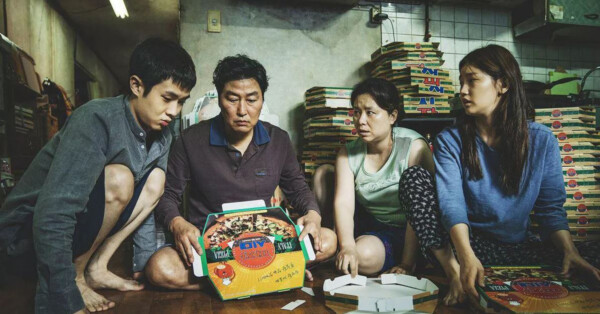
Image courtesy of CJ Entertainment.
“Parasite” Starring Song Kang-ho, Jang Hye-jin, Choi Woo-shik, Park So-dam, Cho Yeo-jeong, Lee Sun-gyun and others. Directed by Bong Joon-ho. 2 hours, 12 minutes. Rated R. Hulu, Amazon Prime.
Del’s take
Maybe it’s a sign of the times that for two years running a movie about class structure has won the Academy Award for Best Picture, or maybe it’s just a reward for classy moviemaking. No matter. “Parasite,” the 2019 Best Picture winner, earns that accolade and then some with its darkly hilarious and stingingly critical look at the way money makes monsters of us all.
In the past, South Korean director Bong Joon-ho used fantasy elements to illustrate the dehumanizing aspects of Western – and now Eastern – culture and its fixation on accumulating wealth at the expense of the planet and its people, but in “Parasite” he brings the argument closer to home with ordinary folks, in this case the Kim family, jumping through extraordinary hoops to escape their poverty and maybe even climb the lower rungs of the ladder to success.
The Kims – father Ki-Taek, mother Chung-sook, sister Ki-jung and brother Ki-Woo – are living in a semi-subterranean roach trap where they fold pizza boxes to earn a living, open their windows when the fumigator comes down their alleyway, and wile away the hours dreaming up scams so they may, in the words of the “Good Times” TV show theme song, begin “movin’ on up to the big time.” An opportunity finally comes their way when Brother Ki-Woo connects with a friend who recommends him for a private teaching job. The wealthy Park family needs a new tutor for their teenaged daughter, and before the movie has finished they will also need a new driver, housekeeper and art therapy teacher for their son – all provided by the Kim family after a bit of slyly funny subterfuge, disinformation and Machiavellian maneuvering.
But karma catches up with the Kims and their machinations pile up like logs stuck in a flume. At that point “Parasite” takes a left turn from a “I Love Lucy”-style farce about a family of ne’er-do-wells creating their own misfortune to a razor-sharp satire about the inequalities of class and how those inequalities can drive some people to madness.
“Parasite” is perfectly acted and written, and I would rate it one of the finest black humor stories ever set to film – up there with “Dr. Strangelove” and “Being There.” It delivers many of its lessons through dialogue. In one scene, the wealthy Parks are having what they think is a private conversation about Mr. Kim and his odor – he smells like old radishes, or the people who ride the subway, Mr. Park muses, to which Mrs. Park replies that she hasn’t ridden the subway in ages. In another scene young Ki-Woo is asking his father if he has a plan for dealing with their latest predicament and the elder Kim replies that indeed he does have a plan, and it is the best plan of all, which is to have no plan because plans fail and leave the planner disappointed and fearful.
As the movie progresses along the trajectory of its increasingly bizarre resolution it becomes impossible not to watch and remains with the viewer long after the closing credits roll. Suffice it to say the Kims might yet climb out of their below-ground-level living conditions but not in the way they planned. Remember: The best plan is to not have a plan.
It took me the first third of the movie to become invested in “Parasite” but once I did I became a huge fan. I think it’s one of the best movies made this century and I will add it to my DVD collection. It’s on Hulu for subscribers, or you can watch it pay-per-view on Amazon Prime.
I give it an A+.
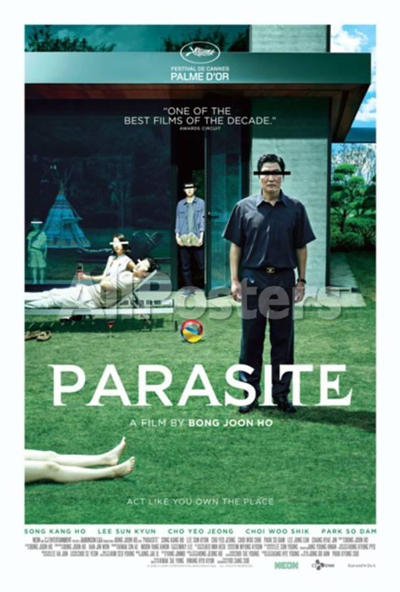
Mladen’s take
Del gives “Parasite” an A+. I give it an A-. The bout of graphic violence at the end distracts the movie. It’s not that the violence is unwarranted. It’s that it should’ve been done with more finesse and less blood.
Del, who’s ordinarily good at summing a movie, misfired on this one. “Parasite” is about both class warfare in the traditional sense – the wealthy pissing on the poor – and interclass warfare between the considerably less well off. To me, that was the movie’s strongest component and lead to its funniest, most satirical scene.
The Kim’s infiltrate the wealthy Park family by shitting on others who are poor or one lost job from tumbling into poordom. One of the Kim shat-upons is the Park’s housekeeper. The Kims connive a way to get her fired so that Mama Kim can take over as the maid. One event leads to another and pretty soon the fired housekeeper and her husband are threatening to expose the Kim con on social media by pressing the “send” button on a cell phone. The kerfuffle that comes along is a hoot. The Kims and the housekeeper (six people) fight up bomb shelter stairs and in a sprawling living room with cell phone imagery and its distribution on the World Wide Web as the prize.
“Parasite” is director Bong Joon-ho at nearly his finest. I’ve watched four of his films. “Snowpiercer” is superb. “Parasite,” along with “The Host” and “Okja” are merely excellent. But they all share a backbone: Mankind is deranged.
Obviously, Bong isn’t the only filmmaker to tackle social injustice. From 1927’s “Metropolis” to 2020’s “Nomadland” the ugliness of our species is well notated. The important part about the message in “Parasite” is that it shows snobbery, greed, selfishness, and disillusionment are the globe’s real currencies. South Korea’s won, the euro, America’s dollar, Brazil’s real, and whatever the fuck Bitcoin is, are just tools that magnify humanity’s flawed, odious character.
I watched “Parasite” with some pleasure. It reinforced what I’ve long known and witnessed almost daily as a newspaper reporter. We the people know what’s going wrong with society. We know what it would take to correct the errors of homelessness, hunger, and medical care rationing based on access to wealth. But we ain’t gonna do nothing about them.
I don’t know. Maybe it’s time that I stop watching films with dire portent or those that feature potent dissection of social ills. Maybe it’s time that I re-watch “E.T. The Extraterrestrial,” “The Princess Bride,” and “The NeverEnding Story” and then stop watching movies all together because they seem to be ever more disturbingly prophetic.
Mladen Rudman is a former journalist and technical writer. Del Stone Jr. is a former journalist and author.
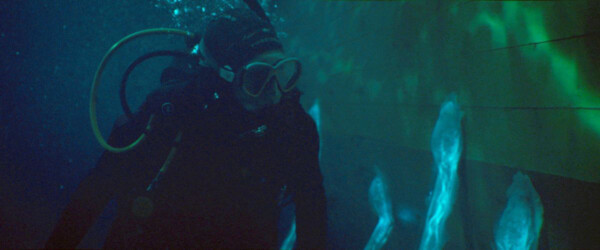
Image courtesy of Signature Entertainment.
“Sea Fever” Starring Hermoine Corfield, Dag Malmberg, Jack Hickey, Dougray Scott and others. Directed by Neasa Hardiman. 95 minutes. Unrated. Hulu, Vudu, Google Play, Amazon Prime, Apple TV+, YouTube.
Del’s take
Oh goodie. Let’s distract ourselves from the pandemic by watching a movie about a pandemic.
Not a pandemic per se but a parasitic infection that threatens to wipe out the crew of an Irish fishing trawler plying the chilly waters of the North Atlantic. That’s the gist of “Sea Fever,” a pretty good little monster movie from director Neasa Hardiman. If films speak to the times, “Sea Fever” is the voice of our COVID-19 consciousness, transposing our empty streets and restaurants with the vacant horizon of the open ocean.
The plot is familiar to fans of “Alien,” “The Thing” and even “The Shining.” Lonely, friendless PhD student Siobhán (Hermoine Corfield) has booked passage on the Niamh Cinn Óir, a rust bucket Irish fishing trawler, to study the behavior patterns of aquatic fauna. The Niamh Cinn Óir is owned and operated by the husband-and-wife team of Gerard (Dougray Scott) and Freya (Connie Nielson); and a crew of four others. Life has not been grand for Gerard and Freya, and they need a good haul this trip or they’ll lose the trawler.
On the trip out they detect a large mass of fish which unfortunately lies within a government-declared exclusion zone. It would be a terrible thing if they accidentally drifted into that exclusion zone and caught a hold full of mackerel, thus saving the Niamh Cinn Óir from receivership and preserving the crew’s livelihoods. Well gosh darn it, guess what happens.
Sometimes exclusion zones exist for more reasons than bureaucratic capriciousness, especially in movies that isolate a small group of people and pits them against a seemingly unbeatable antagonist. It is at this point “Sea Fever” becomes a metaphor for the COVID-19 pandemic as the fishing trawler crew battles a weird aquatic parasite that threatens to kill them all.
But “Sea Fever” operates on a second level, one that addresses the pandemic of loneliness that has infected the world since the invention of digital technology. On her first field study, Siobhán is forced to step out of her reclusive shell and interact, if not befriend, the crew, especially after they discover she’s a redhead (apparently redheads are considered bad luck among Irish fishermen). As the movie progresses along its somewhat predictable trajectory, Siobhán becomes more and more human as her environment descends into science fiction nightmare.
Somehow indie directors always manage to find strong actors to fill their roles and “Sea Fever” is no exception. All the performances are very good but my favorite was Olwen Fouéré as Ciara, the boat’s cook, who carried herself with a chafing blue collar dignity that seemed to perfectly capture the soul of the part. Another strong performance was delivered by Ardalan Esmaili as the boat’s principled and skillful engineer. Weakest was Dougray Scott, whose character hovered somewhere between effective leader and simpering cad. He seemed incapable of communicating the moral ambivalence of a man caught between financial necessity and obeyance of the law.
My gripes with “Sea Fever” are that it wraps up with an anticlimax that feels rushed and out of character for protagonist Siobhán, and the crew’s attempts to resolve their problem seem truncated and drama-less. What would Ellen Ripley have done had she been aboard the Niamh Cinn Óir? That might have elevated the tension considerably.
Still, “Sea Fever” is, as I said, a pretty good little monster movie and your time will not have been wasted, if monster movies are your bag. As American movies become more and more templated by the MBAs working in Hollywood these days, it’s nice to see a movie that still has character and a beating heart.
I grade “Sea Fever” a B or maybe even a B+.
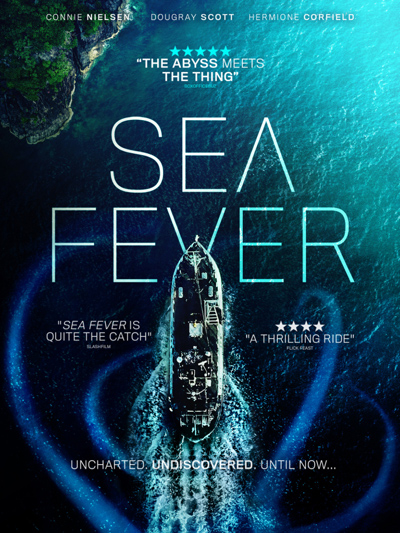
Mladen’s take
Desperation. Superstition. Science. And, a cnidarian. Say it with me, “cnidarian.” I adore that word. It wasn’t in my plain old lexicon of the English language. I had to look it up in my Oxford Dictionary of Science. Cnidarian. Cnidaria is a phylum of aquatic invertebrates that includes hydra, jellyfish, sea anemones, and coral, by the way.
In “Sea Fever,” the crew of the fishing vessel Niamh Cinn Óir become the victims of a cnidarian unknown to humanity. First, the oversized spineless predator whose centrally placed orifice is both mouth and anus, attacks their boat and then it attacks them with its eye-eating larvae.
Where Del sees a SARS-COV-2 angle to “Sea Fever,” I see a straight-up Nature will always kick Man’s ass statement in the film. Humanity believes it controls the planet. The planet disagrees. That disagreement takes many shapes. Climate change. Water shortages. Invasive species. A snowstorm in Texas that has Tumbleweed Cruz abandoning the state he represents in the U.S. Senate to flee to warm and socialist Mexico.
Though the encounter with the cnidarian drives the plot of “Sea Fever,” the story is also about society-induced desperation. The boat owner, who’s married to the captain, has to land a good catch to earn euros to keep the vessel. With that thought plaguing the couple, the captain takes a risk and then the boat owner takes a risk. Both prove fateful.
There is superstition aboard Niamh Cinn Óir. Marine biologist Siobhán, on the boat to conduct field research that her PhD advisor ordered her to do, has red hair, which, as Del points out, the crew consider bad luck. But, there’s also the superstition of religion. There is prayer for a safe journey. There is prayer for a good haul of fish. There are prayers for the dearly departed. And there’s the belief that God will yet protect the crew.
There is science aboard the boat. Siobhán, applying her knowledge, figures out enough about the big cnidarian to give the crew somewhat of a fighting chance to live.
But, in the end, neither God nor science are much help. What mattered was one person sacrificing for another.
“Sea Fever,” as Del claims, is a pretty good little monster movie. I would amend that observation with, “pretty good little sci-fi monster movie.” Though not laden with science, the movie has moments of science-y jargon – “cnidarian” for example – and “bioluminescence” and “holopalegic” and a portable, computer-powered microscope, and talk of water filtration system design. There was the hypothesis that the cnidarian normally parasitizes whales (the fishing boat was in an exclusion zone that existed to protect cetaceans and their calves) and might have mistook the passing shadow of the vessel as a sign of its normal prey.
Between trying to stay alive while a gelatinous, tentacled predator treats them as a larder for its babies and keeping themselves from going berserk under the pressure of looming infection, the crew has to struggle with a bigger question. Is it ethical to return to port when some, if not all, of the crew are nurseries for a novel parasite that could, or is it would, infect landlubbers? Poof, see you later, humanity.
The problem with “Sea Fever” is that it added baggage that didn’t need to be in the film. Too much time was used to set up Siobhán as a loner and it was unconvincing. Del mentioned that the cook carried herself “with a chafing blue collar dignity.” Chafing she was, but it was me who got chafed. The cook went from a semi-pleasant grandmotherly type to an old crone who wanted to kill my beloved Siobhán. What would be the point of killing the one person who had the technical know-how to help people stay alive?
Regrettably, I find myself in the unforgivable situation of agreeing with Del. “Sea Fever” is a B. But for a couple of tweaks, including more encounters with momma cnidarian, this movie would have easily catapulted to an A.
Mladen Rudman is a former journalist and technical writer. Del Stone Jr. is a former journalist and author.

Photo courtesy of Feddacheenee via Creative Commons
Photo courtesy of Feddacheenee via Creative Commons.
—
You are … a radio star. …
You are … a radio star. …
Video killed the radio star.
– The Buggles, “Video Killed the Radio Star,” 1979
Stealing a quick glance at the AM dial on my car radio and then returning my eyes to the road in front of me. Traffic is light this night, with only a handful of taillights slipping past me on Beal Parkway. My tiny Pontiac, 2 years old but new to me, is riding roughly on worn-out tires. In the days ahead comes a visit to the discount tire place down on 98 next to the Dairy Queen.
My whole life lies in front of me.
Years later I will hear Billy Corgan sing “1979” and know he is singing about this night, because it is October 1979 and I have owned this car only two days after landing my first full-time job four months ago and suddenly everything is changing, in every way. I have transportation, a way to escape the claustrophobia of my former life. I have money – money enough to beef up my savings, to buy a movie ticket and pay for a car. I am young and strong and the world is singing to me about everything, not just dead radio stars. I have love to look forward to. I have the astonishment of discovery, the new world that seems to be shaping itself before my eyes, represented by this amazing music I am hearing on the radio – The Knack, Blondie, New England on the FM dial – and I can’t put it all to words but I know something wonderful is happening to me.
I am changing. I can see farther now. My heart is swelling with excitement.
The future. Infinite possibilities.
Cool air rushes into the car. Fall is here and winter is coming. But who cares – I have a car! I can go places. I can do things. The world is limned with possibilities.
The music – thank God for the music. After the long, hot summer of the ’70s, when the stuff coming out of the radio became awful with hard rock, folk, and the horrible disco that lasted only a few years (thank God), a transformation had begun. “My Sharona” and “Heart of Glass” coincided with my emancipation from childhood. They had become my anthems.
So I drive on Beal with only a few other cars and I dream and I know where I am going because I have wanted to go there and now I can – the place where everything I care about is focused. Everything ahead of me, so grand and inexplicable that the fact it cannot be described makes it all the more wonderful. I made it, sort of, and now it is OK, and I think about that, too, when I hear “Video Killed the Radio Star.”
The song reminds me so much of that time, and those are happy memories for me – the glorious, delirious freedom when I didn’t own a damn thing but a crappy Pontiac Astre and the clothes I had just bought from Gayfer’s. I had money but I was always broke. My friends were always broke, and it was a glorious day when Steve’s parents gave him an American Express card and we were able to buy pitchers of beer and a couple of dozen raw oysters at that tired old beach bar next to the Ramada on Okaloosa Island on a gray winter’s afternoon, when the only thing keeping us warm was the candle in the glass holder wrapped in fake fishnet.
Video killed the radio star. When I saw the computer at work, the one with all the wire stories, the news of the entire world, I told myself that if people had one of these things in their homes they’d never buy another newspaper.
And guess what?
Here I am, now, today. Close to the age when Medicare and Social Security become real things to plan on for me, not something I might have heard about on a talk show or read in a magazine story. The music has faded, which suits me because I hate what passes for music these days. I have lots more money than I did in those days but I am still always broke. My car is much nicer than my Pontiac, which I called Blue Thunder. In fact, I have not even bothered to name this latest thing, which could mean I have gotten lazy in my old age or maybe I have just lost the wonder.
Not sure about that. Not sure at all. I still hear echoes of the magic from all those lifetimes ago. I still feel a slight quickening of the heart when certain dreams float to the surface of my thoughts.
It never occurred to me that I am the radio star.
The Buggles were wrong. Video didn’t kill the radio star. He’s still there, waiting for the right time to put on that sparkly jacket and stand in front of the microphone. Or maybe he will appear on a thoughtful night drive on some lonely road.
So tonight, as I came across “Video Killed the Radio Star” and my life flashed before me, I felt inspired to write this about a night long ago, in a beat up old car, when anything seemed possible and the world was filled with wonder.
And you know what?
I’m still the radio star.
—
Author’s note: Contact me at [email protected]. To read more of my opinion and humor pieces, visit delstonejr.com . I also write fiction – horror, science fiction and contemporary fantasy. If you’re a fan of such genres please check out my Amazon author’s page. Print and e-books are both available, and remember: You don’t need a Kindle device to read a Kindle e-book. Simply download the free Kindle app for your smart phone or tablet.
Video
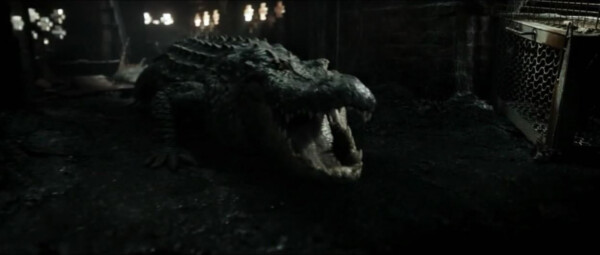
Image courtesy of Paramount Home Entertainment.
“Crawl” starring Kaya Scodelario, Barry Pepper, Morfydd Clark. Directed by Alexandre Aja. 127 minutes. R rated.
Mladen’ take
The film “Crawl” is a model of efficiency and efficacy. In the first, oh, 10 minutes, the audience is introduced to the fact that our heroine Haley is a good swimmer who wants to be gooder; that there’s tension in her family; that a powerful hurricane changed course unexpectedly and is heading for South-ish Florida; that first responders will be unable to help if you’re stranded; that Dad isn’t answering calls or texts; and that the family’s dog faces peril. Hell, even the film’s title is efficient because much of the action takes place in a “Crawl” space beneath a home “Crawl”ing with particularly vicious alligators.
“Crawl” has been graded by IMDB viewers as a mediocre horror movie. They’re wrong. This film is an A-, though it misfires here and there. For example, the first couple of gators to attack Dad and Haley hiss, which is OK, and grumble‑moan like they have larynxes. During courtship, bull gators do generate low-frequency sonic vibrations through the water to show-off their manliness to breed and designate territory. But, in “Crawl”, the gator sonics happen in a largely dry, for the moment, “Crawl” space when, I imagine, the gators were thinking about something other than mating. Don’t misunderstand. The gator grumble‑moans were nothing like the shark in “JAWS IV” (or was that “V”?), breaching and then roaring. Still, making the gators make intimidating noise to add menace to the movie was a tad contrived. Also, the film’s depicted family strife is unneeded and the occasional pep talk from Dad for his daughter Haley’s benefit when her tenacity, spirit, resourcefulness, guts, or hope flag amid heavy rainfall, a flooding house, and death‑by‑gator of a childhood friend languorous. And, yes, there’s the questionable decision to leave the house after Haley and Dad finally escape from the reptile‑infested “Crawl” space to reach a boat by wading a couple of hundred feet through murky, hip-high water.
The boat, by the way, was parked at an inundated gas station and convenience store. It was to be used as the escape vehicle by three people who wanted to steal the store’s ATM. Can you guess what happens to the robbers? The fate of the trio is an example of the many times that “Crawl” excels as creature feature horror.
Del will complain about the jump-out-of-your-seat moments in this movie, but I loved the hell out of them. The gator busting through a staircase. The lightning bolt that illuminates a big‑ass meat eater, jaw agape, behind Haley. And, there’s suspense. Lots and lots of suspense. Reaching from a somewhat safe perch across flood water strewn with floating debris that obstructs your view to get your dead friend’s Glock – he was a sheriff’s deputy – for protection. The dog swimming through a long, darkened hallway to reach Dad. All delightful.
“Crawl” also provides a solid dose of gore. Water turning red as gators bite and thrash their human prey. A death roll. A gator gripping Dad near the elbow, snapping his arm in half and then tearing it off. Floating corpses. Wait to you see how Haley dispatches a gator that has taken hold of her. Dad, too, before losing his arm later in the movie, whacks a gator after trapping it in a clever way.
Sit back, if you can, and enjoy “Crawl”. It’s a masterful little film with likeable characters facing cold‑blooded, almost plausible, threats.
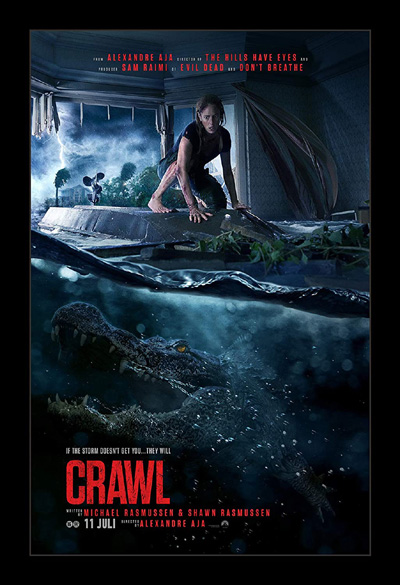
Del’s take
“Crawl” is a two-hour and seven-minute wet T-shirt contest, which explains why Mladen likes it so much.
Me? I can take it or leave it. I have nothing against standard-issue potboilers, even if they’re shameless cash grabs, in this case by the studio and a slumming Barry Pepper, who usually chooses more artistically meritorious projects. But schlock is like Hooters chicken wings – to enjoy them one must be in the mood for them, assuming one can focus on the wings and not the breasts. Maybe I wasn’t in the mood for a serving of grease delivered by a perky coed.
As Mladen explained, the protagonist, Haley, travels two hours south of Gainesville to look for her dad as a cat five hurricane approaches. Dad isn’t answering his phone and Haley’s sister up north fears the worst. Haley and Dad are especially close; she’s a college swimmer and he was her coach throughout her youth. But now she’s having doubts after losing a relay, and somehow that means Dad is a monster, or something like that. You know … something conflicty.
As she treks to the AWOL Dad’s seaside abode she passes a flooded alligator farm. These are the Special Super Intelligent Mind-Reading Alligators from Mars or something based on what happens later in the movie. She finds Dad in the crawl space beneath his house, clawed to damn near bloody ruin by … well, OK. I should let you watch the movie to find out, but, Psssttt! It crawls.
What follows is a string of predictable pitfalls, emotional ups and downs and cliché after soggy, growly cliché. I will give “Crawl” credit – in most of these movies the protagonist is a crack shot who always dodges the falling asteroid and ambles into the sunset with the girl – or boy – slung over his or her shoulder. In “Crawl,” no such immunity is granted, and since it’s a father and daughter there will be no ambling into the sunset. Well, maybe an AARP lecture or two.
No, Mladen, I didn’t object to the jump scares. What I did object to was the stupidity – like helicopters flying in a cat five hurricane. Like people strolling the flooded streets in a cat five hurricane. Like a one-armed guy able to bludgeon his way through a roof with his bare hand.
If you go into “Crawl” with sufficiently low expectations you’ll enjoy it, because it’s a decently entertaining movie with not bad special effects. But that’s all we’re talking here – entertainment. Not art.
I give it between a B- and a C+. Make it a B- because the hurricane actually looked somewhat realistic (although heads up, moviemakers: We just had a cat five here in the Panhandle and there’s tons of footage on YouTube if you’d care to educate yourself about what a storm like that looks like).
Mladen Rudman is a former journalist and technical writer. Del Stone Jr. is a former journalist and author.

Image courtesy of Florida Memory.
This is the Fourth of July I remember.
It is the sepia-toned America of my youth – large cars with tailfins, puffy thunderstorms over Crestview and foil peeled off a Salisbury steak TV dinner. Television stations start their morning broadcast with a noisy rendition of the national anthem.
It is sidewalks and bicycles with fenders and clown-like horns with big, rubbery bulbs. Mom throws us out of the house in the morning and tells us to go play, so we wander the neighborhood, looking for our friends, drinking out of outdoor spigots when we get thirsty and working on our sunburns that will be sponged with vinegar that night.
It’s riding our bicycles into the billowing white cloud behind the mosquito sprayer and peeking through the front window at a green TV screen, because the next-door neighbor is the only person on our street with a color TV and we think it’s amazing.
Or standing on the weedy shores of Cinco Bayou at the foot of Cinco Bridge as water skiers jump over ramps and carry beautiful girls on their shoulders, and if you wait until dusk some guys of questionable sobriety will show up in a boat and launch fireworks they brought back from Alabama.
It’s beauty contests on the beach and cooking burgers on the nasty grills at Wayside Park on the island and marveling over the giant shark hanging tail-first from the fishing pier with its guts spilling out while people pose for photos.
You can buy an alligator at a tourist trap for a dollar, a real alligator, and Tower Beach serves the best burgers on the planet – buns heated on the cooktop and smeared with grease, exactly the way they should be – and the PA system thunders “I can’t get no satisfaction” while girls with lacquered hair and guys with slicked-back Vitalis curls gyrate to unfathomable rhythms.
And then at night it’s standing in the driveway with a Tasco reflector and gazing at the moon or a wobbly image of Mars or pale Saturn with its strange rings. You have to smear Off cream on your arms and legs because despite the fogger that left the neighborhood smelling like a chemical factory, the mosquitoes are tougher than a little DDT and they’ll eat you alive.
This is the July Fourth I remember.
The best July Fourth ever.
About the author:
Del Stone Jr. is a professional fiction writer. He is known primarily for his work in the contemporary dark fiction field, but has also published science fiction and contemporary fantasy. Stone’s stories, poetry and scripts have appeared in publications such as Amazing Stories, Eldritch Tales, and Bantam-Spectra’s Full Spectrum. His short fiction has been published in The Year’s Best Horror Stories XXII; Alfred Hitchcock’s Mystery Magazine; the Pocket Books anthology More Phobias; the Barnes & Noble anthologies 100 Wicked Little Witch Stories, Horrors! 365 Scary Stories, and 100 Astounding Little Alien Stories; the HWA anthology Psychos; and other short fiction venues, like Blood Muse, Live Without a Net, Zombiesque and Sex Macabre. Stone’s comic book debut was in the Clive Barker series of books, Hellraiser, published by Marvel/Epic and reprinted in The Best of Hellraiser anthology. He has also published stories in Penthouse Comix, and worked with artist Dave Dorman on many projects, including the illustrated novella “Roadkill,” a short story for the Andrew Vachss anthology Underground from Dark Horse, an ashcan titled “December” for Hero Illustrated, and several of Dorman’s Wasted Lands novellas and comics, such as Rail from Image and “The Uninvited.” Stone’s novel, Dead Heat, won the 1996 International Horror Guild’s award for best first novel and was a runner-up for the Bram Stoker Award. Stone has also been a finalist for the IHG award for short fiction, the British Fantasy Award for best novella, and a semifinalist for the Nebula and Writers of the Future awards. His stories have appeared in anthologies that have won the Bram Stoker Award and the World Fantasy Award. Two of his works were optioned for film, the novella “Black Tide” and short story “Crisis Line.”
Stone recently retired after a 41-year career in journalism. He won numerous awards for his work, and in 1986 was named Florida’s best columnist in his circulation division by the Florida Society of Newspaper Editors. In 2001 he received an honorable mention from the National Lesbian and Gay Journalists Association for his essay “When Freedom of Speech Ends” and in 2003 he was voted Best of the Best in the category of columnists by Emerald Coast Magazine. He participated in book signings and awareness campaigns, and was a guest on local television and radio programs.
As an addendum, Stone is single, kills tomatoes and morning glories with ruthless efficiency, once tied the stem of a cocktail cherry in a knot with his tongue, and carries a permanent scar on his chest after having been shot with a paintball gun. He’s in his 60s as of this writing but doesn’t look a day over 94.
Contact Del at [email protected]. He is also on Facebook, twitter, Pinterest, tumblr, TikTok, Ello and Instagram. Visit his website at delstonejr.com .
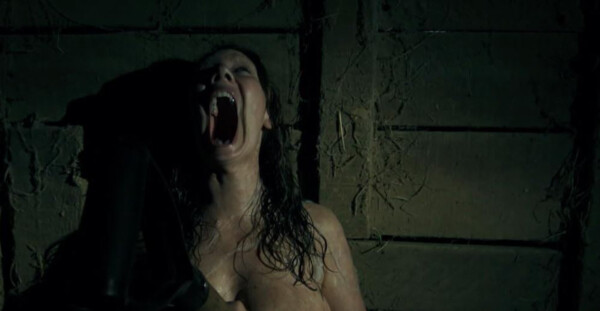
Image courtesy of Gravitas Ventures.
“Assimilate” Starring Joel Courtney, Calum Worthy and Andi Matichak. Directed by John Murlowski. 1 hour, 33 minutes. Not rated.
Del’s take
It was a tweet that led me to the Refinery 29 list of 130 best new movies on Netflix, and from that I made my own list because I don’t see myself watching sappy holidays flicks where the man and woman fall in love despite their political differences (The very idea bludgeons my suspension of disbelief).
That’s how I tumbled onto “Assimilate,” which shares a common trait with “Spiderman.” How?
The two are part of an endless cycle of recycling.
How many versions of “Spiderman” will Hollywood make before they finally leave it alone? Same goes for “Invasion of the Body Snatchers,” the 1956 classic about the Red Scare. “Assimilate” is, what, the fourth of fifth iteration of that movie? I’ve lost count.
Far be it from me to criticize – I watched the whole damn thing. But honestly: Hollywood, do you need a new scary sci-fi horror movie idea? I’ve got several available if you can lay off the sequels and re-imaginings and revisions.

“Assimilate” takes place in a small town called Multon, Missouri, which looks pretty nice to me – neat and clean, with lots of well kept homes, sparse traffic and a lack of crime that allows you to leave your doors unlocked at night. And it’s those qualities that make Multon a living hell for Zach (Joel Courtney), Randy (Calum Worthy) and Zach’s crush, Kayla (Andi Matichak).
Zach can’t leave because his father lost the use of his legs in … well, I don’t remember the movie explaining that detail. But Zach must stay to help his mother take care of his dad. Randy can’t leave because he’s a loser. Kayla IS leaving and the threat of her absence might prompt Zach into revealing his decade-long crush on her … but the monsters upend that timetable.
Zach and Randy are passing the summer making a vlog about how boring their town is, which they somehow expect people to watch. The video from their cameras provides footage throughout the movie but we’re not talking found-footage; “Assimilate” is mostly live action, thank God.
Strange things begin to happen in Multon as (a) weird little bugs appear and (b) even stranger, floating spore-like organisms take to the Missouri skies, except only WE can see them. That struck me as odd – why two possible catalysts for the invasion we know is already taking place?
People begin taking on the flat affect of a telemarketer (unless it’s Candi, who calls me at least once a month to discuss how I could improve my credit score) and soon Zach and Randy are asking themselves who can be trusted, especially after Mrs. Henderson evolves from horny sex addict to prudish schoolmarm in a single evening. Kayla joins their ranks after her own father becomes robotic and unearthly.
What follows is the usual “Body Snatchers” process whereby the protagonist(s) try to make others aware of the danger and when that doesn’t work, escape themselves.
I mean, what can I say? It wasn’t awful and I don’t have many gripes – the dual-threat thing, yes. That was unnecessary. Oh, and they kept saying they would rescue Kayla’s little brother from the pod people but leaving him with the pod people. The ending departed from most, but not all of the earlier versions, if that’s a virtue.
Other than that, “Assimilate” was nothing more than a 2019 refresh of a 50-something-year-old classic featuring young actors who might be recognizable to the current generation (Courtney starred in the JJ Abrams movie “Super 8” and Worthy was the goofy sidekick in Disney’s “Austin & Alley”). It broke no new ground, but neither did it salt the earth of its predecessors.
I watched it on Netflix and didn’t hate it, hence a C+ grade.
Stone is a former journalist and author.